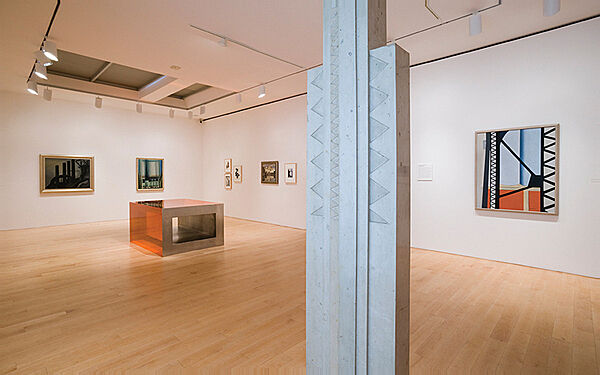George Bellows
1882–1925
With his depictions of streetscapes, tenements, athletes, and city dwellers, George Bellows became one of the foremost exponents of urban realist painting in the early years of the twentieth century. At the outset of his career, Bellows emulated the loose brushwork of his mentor, leading Ashcan School figure Robert Henri, but by the 1920s he had shifted to a stylized aesthetic of smooth curves and monumental, tubular forms, as in Dempsey and Firpo, one his most ambitious late paintings.
To supplement his income as a painter, Bellows worked as a newspaper sports illustrator, and the events he covered often found their way into his art. Here he portrays a pivotal moment in the famous prizefight between American heavyweight champion Jack Dempsey and his Argentine rival, Luis Firpo, on September 14, 1923, at the Polo Grounds in New York. Dempsey was the eventual victor, but Bellows represents the startling moment when Firpo knocked his opponent out of the ring with a tremendous blow to the jaw. The painting’s drama hinges on its underlying compositional structure: Firpo’s erect body forms a powerful triangle, the leftward diagonal of his swinging fist providing a forceful counter to Dempsey’s overturned body. Bellows was present among the journalists at ringside, and art historians have suggested that either the bald figure at the far left or the man beneath Dempsey, pushing him back up, could have been based on the artist himself. Although Firpo had launched Dempsey out of the ring with his notorious right hook, the artist instead portrayed him swinging with his left. For Bellows, amplifying geometric tension took precedence over anecdotal detail.
Dana Miller and Adam D. Weinberg, Handbook of the Collection (New York: Whitney Museum of American Art, 2015), 61.
Introduction
George Wesley Bellows (August 12 or August 19, 1882 – January 8, 1925) was an American realist painter, known for his bold depictions of urban life in New York City. He became, according to the Columbus Museum of Art, "the most acclaimed American artist of his generation".
Wikidata identifier
Q167132
Information from Wikipedia, made available under the Creative Commons Attribution-ShareAlike License . Accessed December 24, 2025.
Introduction
American painter and lithographer, he studied with Robert Henri at the New York School of Art, directed by William Merrit Chase. He initially resided at the YMCA of 57th Street, and the urban landscape of New York and its inhabitants were the main subjects of his works. He is probably best known for his gritty images of prizefighters in the ring, painted in a tonal palette with broad brushstrokes, evoking the tawdry underworld of prizefighting clubs at the turn of the century. Bellows was associated with the Ashcan School of painting and helped organize the Armory Show of 1913. American painter.
Roles
Artist, illustrator, landscapist, lithographer, painter
ULAN identifier
500003261
Names
George Bellows, Dzhorzh Bellouz, Bellows, George Wesley Bellows, geo bellows, geo. bellows, george bellows
Information from the Getty Research Institute's Union List of Artist Names ® (ULAN), made available under the ODC Attribution License. Accessed December 24, 2025.









